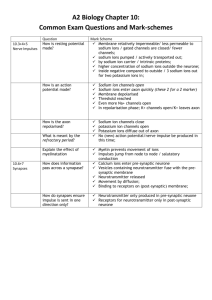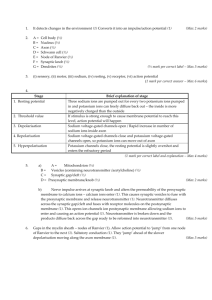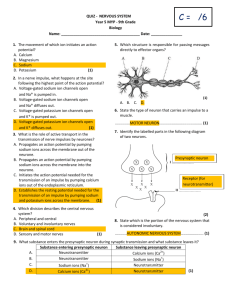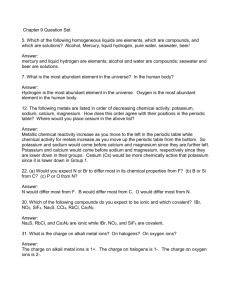Metals - Mwiseman.com
advertisement
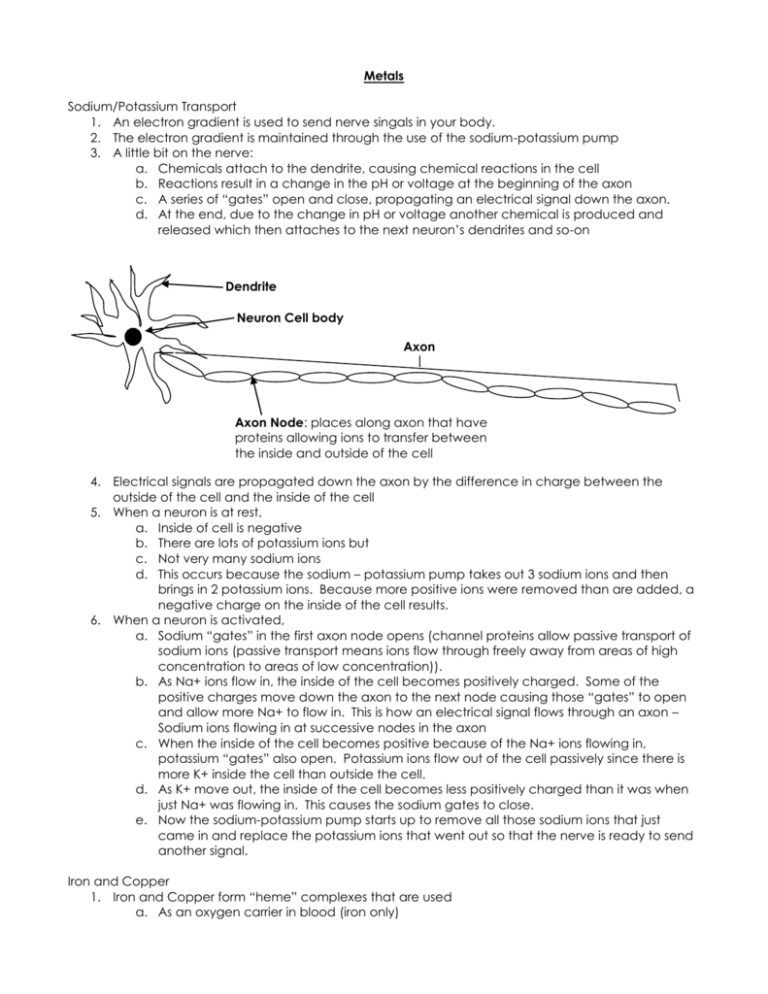
Metals Sodium/Potassium Transport 1. An electron gradient is used to send nerve singals in your body. 2. The electron gradient is maintained through the use of the sodium-potassium pump 3. A little bit on the nerve: a. Chemicals attach to the dendrite, causing chemical reactions in the cell b. Reactions result in a change in the pH or voltage at the beginning of the axon c. A series of “gates” open and close, propagating an electrical signal down the axon. d. At the end, due to the change in pH or voltage another chemical is produced and released which then attaches to the next neuron’s dendrites and so-on Dendrite Neuron Cell body Axon Axon Node: places along axon that have proteins allowing ions to transfer between the inside and outside of the cell 4. Electrical signals are propagated down the axon by the difference in charge between the outside of the cell and the inside of the cell 5. When a neuron is at rest, a. Inside of cell is negative b. There are lots of potassium ions but c. Not very many sodium ions d. This occurs because the sodium – potassium pump takes out 3 sodium ions and then brings in 2 potassium ions. Because more positive ions were removed than are added, a negative charge on the inside of the cell results. 6. When a neuron is activated, a. Sodium “gates” in the first axon node opens (channel proteins allow passive transport of sodium ions (passive transport means ions flow through freely away from areas of high concentration to areas of low concentration)). b. As Na+ ions flow in, the inside of the cell becomes positively charged. Some of the positive charges move down the axon to the next node causing those “gates” to open and allow more Na+ to flow in. This is how an electrical signal flows through an axon – Sodium ions flowing in at successive nodes in the axon c. When the inside of the cell becomes positive because of the Na+ ions flowing in, potassium “gates” also open. Potassium ions flow out of the cell passively since there is more K+ inside the cell than outside the cell. d. As K+ move out, the inside of the cell becomes less positively charged than it was when just Na+ was flowing in. This causes the sodium gates to close. e. Now the sodium-potassium pump starts up to remove all those sodium ions that just came in and replace the potassium ions that went out so that the nerve is ready to send another signal. Iron and Copper 1. Iron and Copper form “heme” complexes that are used a. As an oxygen carrier in blood (iron only) b. As part of cytochromes used for electron transport in the mitochondria (electron transport facilitates the formation of ATP) 2. the heme complex results when the iron or copper ion forms a coordination complex 3. Coordination complex is a metal ion surrounded by 2 to 8 ligands. 4. A ligand is an ion or other neutral molecule that has a lone pair which it can donate to the ion to form a coordinate covalent bond without changing the charge on the ion. H2 O OH2 H2O ++ Fe OH2 H2O H2 O 5. The size, charge and electron configuration of the ion determine the number of ligands that a particular ion can have 6. Ions will hybridize empty orbitals to form a linear, tetrahedral, square planar or octahedral formation with their ligands. 7. Complex ions of transition metals are often colored. This is because the electrons of the dorbtials are repelled by the ligands by different amounts. The d-orbital electrons, therefore, exist in higher energy states. Two d-orbitals, however, exist in a higher energy state than the other 3. The difference between the two d-orbitals and the 3 d-orbitals determines the color of the complex. Light can be absorbed to promote an electron in a d-orbital at a lower energy state to a d-orbital in a higher energy state. The color of light absorbed by the complex has the same energy as the difference in the energy states of the d-orbitals. The color seen is the color that is not absorbed by the complex. Iron’s role in blood 1. There are four “heme” complexes in each hemoglobin protein 2. Each heme can hold one O2 molecule. 3. Iron’s affinity for O2 depends on the shape of the heme. 4. The shape of the heme changes depending on whether or not the carboxylic acid groups are protonated or not. 5. Reactions that govern the uptake of O2 and CO2 are: a. CO2 + H2O HCO3- + H+ b. Hb(O2)nHx + O2 Hb(O2)n+1 + xH+ c. When lots of CO2 is present, i. carbonic acid is made, resulting in excess protons. ii. Excess protons, protonate the heme causing it to change shape and release oxygen. iii. This occurs in the muscle cells, the opposite process happens in the lungs 6. Generally iron (II) will oxidize even further in the presence of oxygen – why doesn’t it in our blood? a. In order to oxidize to Iron (III), two heme groups have to line up and share an oxygen molecule between them : ---Fe---O=O---Fe---b. Because of the globular proteins attached to each heme, the heme complexes are prevented from lining up like that. 7. Color of blood a. Remember the complex ions are colored…iron(II) fluctuates between red and blue depending on whether it has binded with oxygen. If it binds with oxygen, the electron density of the molecule changes (the d-orbitals move farther apart and more blue light is absorbed while red light is reflected). This is why oxygenated blood is red and deoxygenated blood is blue. b. Old dried blood is brown because the iron (II) has been oxidized to Iron (III).

